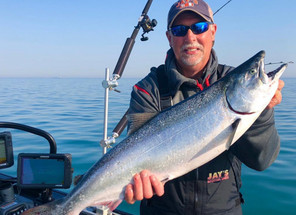Posted by Chris Larsen on 29th Jan 2021
Tipping Baits For More Bites
Mark Romanack from Fishing 411 TV has fished big water for decades. He has a degree in fisheries and wildlife management and has literally made fishing his life. One of his favorite tactics for catching more fish while trolling is tipping crankbaits with live bait. “It’s an old school technique and I’m an old school kind of guy. It was something we would do decades ago. Essentially what we would do is to take a lure we had confidence in and in order to get a better scent stream in the water, we would tip it with some type of live bait. Generally speaking, we would use a nightcrawler because it’s really easy to work with.”
 If the action is slow, one of the first adjustments Romanack makes is adding meat to the presentation. “If it’s not getting bit, one of the things you can do to improve its action and improve its catchability is to take a little piece of nightcrawler, I’m talking about a one-inch piece, and put it on the front treble hook of that lure. Now when you put it in the water you have a scent stream, a natural scent stream in the water. You also have a wiggling thing there that’s a little more enticing. You would be amazed at how often that little tiny thing makes a difference.”
If the action is slow, one of the first adjustments Romanack makes is adding meat to the presentation. “If it’s not getting bit, one of the things you can do to improve its action and improve its catchability is to take a little piece of nightcrawler, I’m talking about a one-inch piece, and put it on the front treble hook of that lure. Now when you put it in the water you have a scent stream, a natural scent stream in the water. You also have a wiggling thing there that’s a little more enticing. You would be amazed at how often that little tiny thing makes a difference.”
Tipping can increase success with a number of species. “Some species, like trout, are notorious for this. You can’t get them to bite hardware but if you tip your lure, you can get them to bite it. Walleye is another one that is very notorious for this. If you just can’t get walleyes to bite for one reason or another, a little live bait tip on that hook makes all the difference some days. It doesn’t work every day but sometimes it will make you look like a hero.”
Romanack suggests putting the nightcrawler on the front hook of your crankbait. “You can do it both ways but the front treble is going to be less likely to change the action of the bait. Most wobbling plugs are very sensitive to weight. If you put too big of hook on that can ruin the action of it. If you put the piece of bait on the back hook it can be very enticing but it can very easily change the action. Plus, I want that fish to get as much of that crankbait in its mouth as possible. I don’t want him nipping at the back treble hook and maybe just pulling off the nightcrawler. I want him to eat the whole plug and the best way to do that is to make him aim for the front of the plug.”
According to Romanack, cold water situations are perfect for tipping. “Invariably, when we’re fishing any species in cold water, they’re lethargic. Fish are cold-blooded creatures. When the water is cold they’re not as active. Tipping can be very effective in cool water. I describe cool or cold water as anything below 50 degrees. If we’re doing this for trout and salmon we’re often targeting them in very cold water. It definitely makes a difference. If you’re doing this for walleye it may be a little warmer. But it is still effective. Still gives you that scent stream. It still gives you that little extra action you can’t get without tipping.”
Mark Romanack was a recent guest on the Great Lakes Fishing Podcast. To listen to the full conversation, click on the player below or go to our podcast page.

